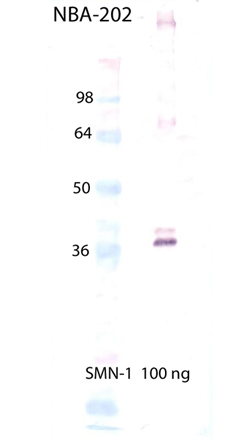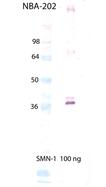Product Details
| Alternative Name: | Survival Motor Neuron |
| |
| Clone: | 2B1 |
| |
| Host: | Mouse |
| |
| Isotype: | IgG |
| |
| Immunogen: | Recombinant fragment corresponding to the carboxy-terminus of human SMN1. |
| |
| UniProt ID: | Q16637 |
| |
| Source: | Purified from hybridoma tissue culture supernatant. |
| |
| Species reactivity: | Human
|
| |
| Applications: | WB
|
| |
| Recommended Dilutions/Conditions: | Western Blot (1:1,000, colorimetric)
Suggested dilutions/conditions may not be available for all applications.
Optimal conditions must be determined individually for each application. |
| |
| Application Notes: | Detects a band of ~38kDa by Western blot. |
| |
| Purity Detail: | Protein G-affinity purified. |
| |
| Formulation: | Liquid. In PBS, pH 7.2, containing 0.09% sodium azide. |
| |
| Handling: | Avoid freeze/thaw cycles. |
| |
| Shipping: | Blue Ice |
| |
| Long Term Storage: | -20°C |
| |
| Scientific Background: | Survival Motor Neuron (SMN) is a ~38 kDa protein produced chiefly by the SMN1 gene, located on the telomeric portion of chromosome 5q. A nearly identical centromeric copy of the gene (SMN2) also produces a small amount of full-length SMN protein, but due to a translationally silent C(R)T transition that results in alternative splicing of the pre-mRNA, most of the resulting SMN is truncated, causing reduced protein stability and lower overall SMN levels. Deletion or mutation of the SMN1 gene results in a reduced level of full-length SMN protein and manifests as a range of neuromuscular phenotypes in humans as the disease spinal muscular atrophy (SMA). SMA is characterized by muscle weakness and atrophy, functional disability and is the most common lethal genetic disease of infants and toddlers. Approximately one in 35 adults is a carrier of the SMN1 mutation. The incidence of SMA is 1 in 6,000 to 1 in 10,000 live births. SMN protein is present in the cell cytoplasm, and also in the nucleus where it is concentrated in “gem” structures associated with Cajal bodies. SMN protein is a constituent of Gemin-containing complexes, and is thought to participate in many aspects of RNA metabolism. SMN complexes have been shown to mediate the assembly of uridine-rich small nuclear ribonucleoproteins (snRNPs), which in turn act as critical components of spliceosomes. |
| |
| Regulatory Status: | RUO - Research Use Only |
| |

Western Blot Analysis of SMN1, mAb (2B1) (Prod. No. NBA-202). Lane 1: MWM, Lane 2: Empty; and Lane 3: SMN1 (human), (recombinant) (His-tag) (Prod. No. NBP-201).
Please mouse over
Product Literature References
SMN Protein Can Be Reliably Measured in Whole Blood with an Electrochemiluminescence (ECL) Immunoassay: Implications for Clinical Trials: P. Zaworski, et al.; PLoS One
11, e0150640 (2016),
Abstract;
General Literature References
Regulation of SMN protein stability: B.G. Burnett, et al.; Mol. Cell. Biol.
29, 1107 (2009),
Abstract;
Molecular mechanisms of spinal muscular atrophy: C.J. Sumner; J. Child Neurol.
22, 979 (2007),
Abstract;
The spinal muscular atrophy disease gene product, SMN: A link between snRNP biogenesis and the Cajal (coiled) body: T. Carvalho, et al.; J. Cell Biol.
147, 715 (1999),
Abstract;
SMN oligomerization defect correlates with spinal muscular atrophy severity: C.L. Lorson, et al. ; Nat. Genet.
19, 63 (1998),
Abstract;
The SMN-SIP1 complex has an essential role in spliceosomal snRNP biogenesis: U. Fischer, et al.; Cell
90, 1023 (1997),
Abstract;
The spinal muscular atrophy disease gene product, SMN, and its associated protein SIP1 are in a complex with spliceosomal snRNP proteins: Q. Liu, et al.; Cell
90, 1013 (1997),
Abstract;
Identification and characterization of a spinal muscular atrophy-determining gene: S. Lefebvre, et al.; Cell
80, 155 (1995),
Abstract;
Genetic mapping of chronic childhood-onset spinal muscular atrophy to chromosome 5q11.2-13.3: L.M. Brzustowicz, et al.; Nature
344, 540 (1990),
Abstract;
Mapping of acute (type I) spinal muscular atrophy to chromosome 5q12-q14. The French Spinal Muscular Atrophy Investigators: J. Melki, et al.; Lancet
336, 271 (1990),
Abstract;
Incidence, prevalence, and gene frequency studies of chronic childhood spinal muscular atrophy: J. Pearn; J. Med. Genet.
15, 409 (1978),
Abstract;












